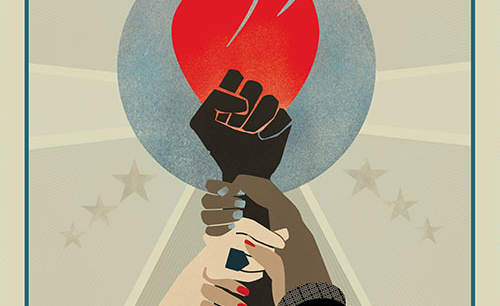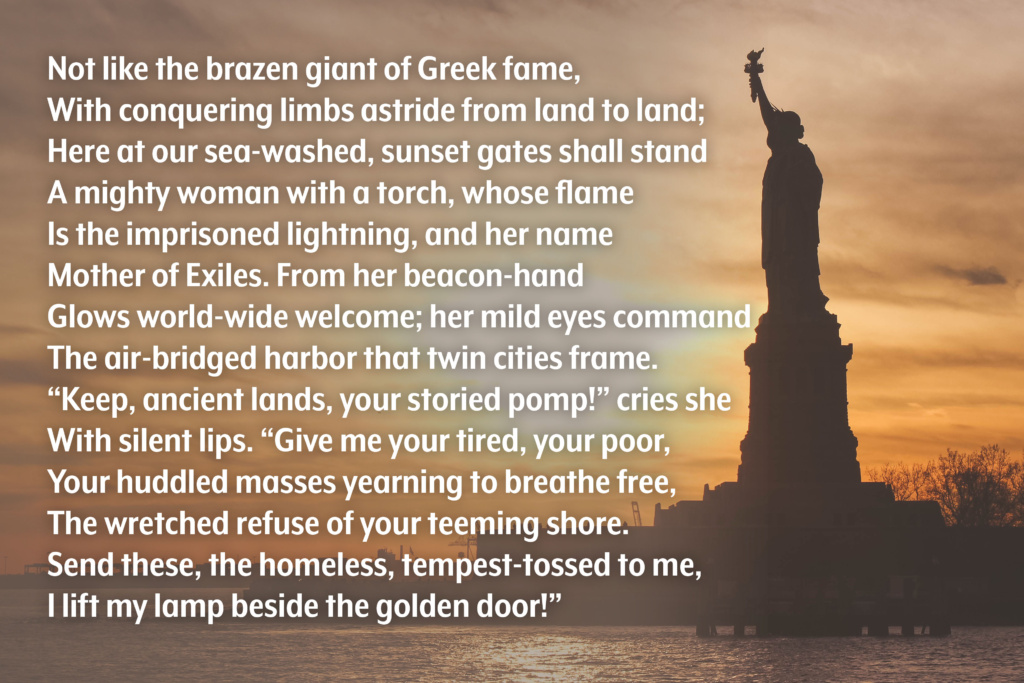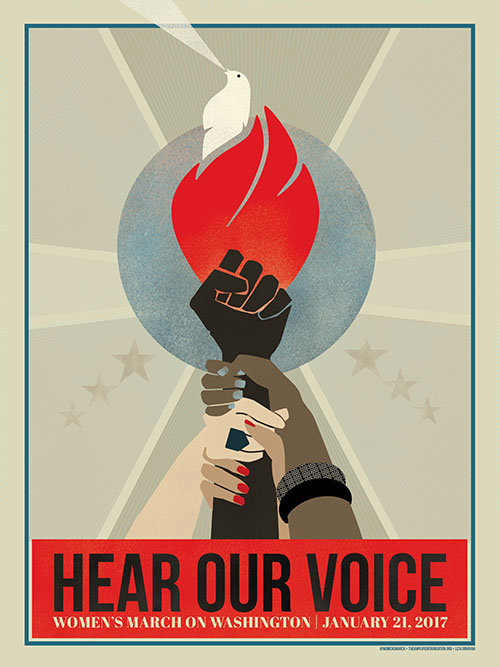Marching Toward a Feminine Future

Today, Donald J. Trump was inaugurated as the 45th president of the United States of America. Every single day since the election, I have spent countless hours thinking about what this presidency – born in an atmosphere of fear, anger, hate, and authoritarianism – means for the future of the great American dream and experiment. During this time, I have also been reflecting on the less familiar but equally powerful lines of Emma Lazarus’ sonnet “New Collosus,” emblazoned on the pedestal of the Statue of Liberty:

The famed statue was designed to resemble the Roman goddess of freedom Libertas by French sculptor Frédéric Auguste Bartholdi, chosen due to her widespread representation on American coins, popular and civic art, and federal and capitol buildings.1
Apart from noting the various allegorical symbols adorning the statue, it’s important for us to ask why the early-American artists and Bartholdi himself chose a woman to represent liberty and freedom.2 Why is it a she who holds a torch on Liberty Island? Why do her eyes command the New York City harbor? Why do her silent lips cry for the tired, poor, homeless, and tempest-tossed to be sent to her golden door?
In an essay from the National Council for Civil Liberties, Barbara Taylor offers a profound yet poignant answer:
As the more animalistic, the ‘wilder’ sex – the sex which must be ruled rather than ruling – Woman embodies a primal lust for liberty. The ironies are obvious: ‘No visitor, looking up at the colossus of the Statue of Liberty, imagines her appearance as a sign that women…enjoy privileged access to freedom.’ As an allegory of Liberty, Woman symbolizes a passion for freedom inherent to all human beings, while at the same time exposing the limits of liberty as an abstract ideal. What does liberty mean for women in a male-dominated world?3
What does liberty mean in a world like Silicon Valley, where women hold only 11% of executive positions? Where women often abandon their passion for science and technology early in their careers due to unmerciful harassment and belittlement from male-dominated culture? As Nina Burleigh states in Newsweek Magazine, “It wouldn’t be an exaggeration to say that a front line, if not the trench of the global gender war, is in Silicon Valley. In that sense, Silicon Valley culture echoes the Wolf of Wall Street culture in the ’80s and ’90s. But while Wall Street today seems tamer—thanks to lawsuits and diversity consultants in every corner—in Silicon Valley the misogyny continues unabated.”4
What does liberty mean in the world of media, literature, and entertainment where women are still largely portrayed as sex icons, and the male-dominated culture continues to sell the concept that a woman or young girl’s value is found in their beauty, youth, and sexuality? According to Sifat Azad in the online magazine Mic, “Typically, female characters in film and television were not portrayed in leadership roles and were less likely than male characters to achieve their goals. Amongst the 10 top-grossing films of 2010, three of those films were considered ‘woman-centric.’ Only 19 out of the 100 top-grossing films were given that title… Female characters were more likely to be depicted wearing sexy clothing, partially nude, and referred to as attractive in comparison to male characters.”5
What does liberty mean in the world of governance and politics where women are shockingly marginalized, and where local, national, and global policy often reflects a bias against females? As noted by Equality Indicators at the CUNY Institute for State and Local Governance, “Women comprise half of the U.S. and world populations but are highly underrepresented at all levels of government. (22.8% of national parliaments are women, 19.4% of the U.S. Congress is women, and 24.6% of U.S. state legislatures are women.) The consequences of the gender gap in political leadership go beyond issues of democratic representation. Studies have found that, on average, women elected officials introduce more legislation than men, and that they do so on a wide range of issues, from health and education to infrastructure and the environment. On balance, women elected officials have also been found to be more transparent, collaborative, and effective.”6
And so, I return once again to pondering the future of a world in which the new president of the United States has displayed an unprecedented level of hate toward women.
I think specifically about the future of my two daughters – ages 17 and 19 – who are on the cusp of entering adulthood. What will liberty look like for them? Will they walk away from their potential due to a landscape of increasing hostility toward female intellectuals, professionals, and entrepreneurs? Will they see themselves as builders of healthy social images and human development, or will they believe that their true value is as a play-thing for men to grab by the genitals whenever they feel the need or desire? Will they realize their inherent power to lead the world toward greater transparency, collaboration, and effectiveness, or will they live under the oppression of more anti-female decisions and policies?

I ask myself these questions because the incoming president does not value the true meaning of liberty. I watched him promise to “make America great again,” and I heard his followers interpret those words as a rally-cry for some bygone form of liberty that they feel they have lost. But fear, anger, and an iron fist are not the equivalent of liberty. As Taylor notes, “So long as women remained subordinate to men, ‘convenient slaves’ rather than equal citizens, true liberty would be impossible.” Quoting revolutionary feminist Mary Wollstonecraft, Taylor continues, “this virtuous equality will not rest firmly even when founded on a rock, if one half of mankind be chained to its bottom.”3
It is for this reason – and many others that relate to defending the great American dream and experiment – that you will find me marching alongside a historic number of women at The Women’s March on Washington on January 21st, 2017 in Washington, D.C. Already, over 100,000 women (and men) are expected to “join in diversity” to “send a bold message to our new government on their first day in office, and to the world that women’s rights are human rights…there is no true peace without justice and equity for all.”7
If you cannot attend the march in person, I hope you will support those individuals and organizations who make a difference everyday in not only assuring access to equal healthcare, education, and legal rights for women, but also promoting the rise of women (and the feminine spirit) across all levels and domains of society. If you do, then you will be empowering Liberty’s “primal lust” and “passion for freedom inherent to all human beings,” and you will exemplify her beacon-hand that glows world-wide welcome beside the golden door.
Follow along with our story here as we march in Washington, D.C.
P.S. Isn’t it crazy to think that the message of our last president was “Yes, We Can” (a message of forward-looking hope, transformation, and aspirational change at its core) and the message of the incoming president is “Make America Great Again” (a message of backwards-looking recapture, authoritarianism, and fear-induced separation from an increasingly globalized world)? As you may have noticed, I do not play well with fear as a motivator for platforms of non-emergent, artificial, or manufactured landscapes of change, and I do not see “backwards” as a way to ever arrive a better future for all.
- Source: https://en.wikipedia.org/wiki/Statue_of_Liberty
- Of course, Justice is also represented as a female, the Roman goddess Themis or Justicia, and is associated with other socially allegoric goddesses such as Astraea, Dike, Fortuna, Eunomia, Eirene, Tyche, and Ma’at. Read more here: http://sculptorsdominion.org/UserFiles/File/08LadyJusticePressCOPY.pdf
- Source: http://www.liberty80.org/writers-project/barbara-taylor-liberty-woman
- Source: http://www.newsweek.com/2015/02/06/what-silicon-valley-thinks-women-302821.html#sthash.D9caKYd1.dpuf
- Source: https://mic.com/articles/4439/are-women-in-the-media-only-portrayed-as-sex-icons-statistics-show-a-massive-gender-imbalance-across-industries
- Source: http://equalityindicators.org/women-in-politics/
- Source: https://www.womensmarch.com/mission/

Frank Spencer
Co-Founder
Creative Director
In 2009, Frank founded Kedge – a global foresight, innovation, and strategic design firm which pioneered TFSX. Throughout his career, Frank has worked as a leadership coach and developer with entrepreneurs, social communities, networking initiatives, and SMEs, helping them in areas such as development, innovation, and networking.
Read More
